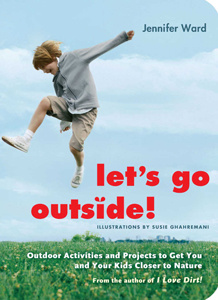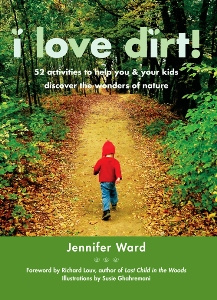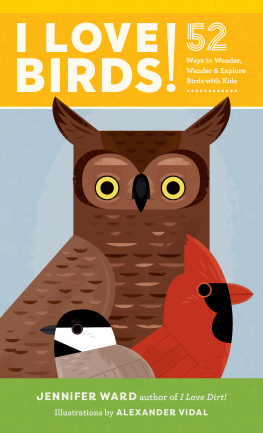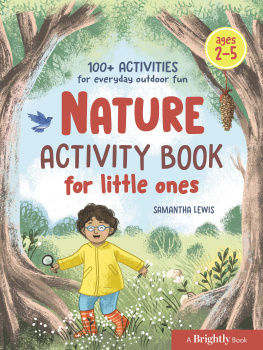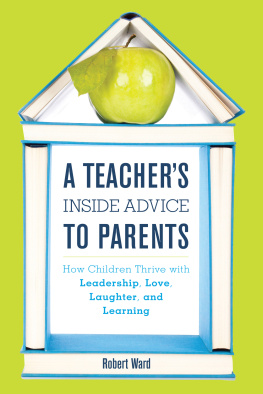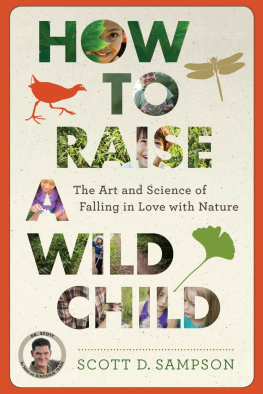Here is the potential for much fun, many meaningful experiencesand a trove of shared stories.
Richard Louv, from the foreword
There may be no better way to ensure the well-being of the natural world tomorrow than to introduce children to its many small wonders today. Through a series of accessible activities designed to engage young minds and all five senses, this book reminds us ofeven celebratesthe magic to be found right outside our own back doors.
Todd Christopher, National Wildlife Federations Green Hour
I Love Dirt! is a perfect book for parents, teachers, or anyone who cares about children and nature. A nature-lover herself, Jennifer Ward has done an excellent job creating a collection of fun, interactive ways for children everywhere to connect with nature and combat the growing negative impact of sedentary, indoor lifestyles on our youth.
David Mizejewski, Naturalist, National Wildlife Federation and Host of Animal Planets Backyard Habitat
ABOUT THE BOOK
I Love Dirt! presents 52 open-ended activities to help you engage your child in the outdoors. No matter what your locationfrom a small patch of green in the city to the wide-open meadows of the countryeach activity is meant to promote exploration, stimulate imagination, and heighten a child's sense of wonder.
To learn more about the author, Jennifer Ward, visit her website at jenniferwardbooks.com, and to learn more about the illustrator, Susie Ghahremani, visit her website at boygirlparty.com.
JENNIFER WARD is the author of numerous acclaimed parenting books and books for children, inspired by nature. She lives in southern Illinois with her daughter, their dog, Bandit, and a cat they call Jaz. When not writing, Ward is unplugged and outdoors, where youll find her canoeing, jogging, gardening, bird watching, or barefoot and cloud gazing.
Sign up to receive free projects and special offers from Roost Books.

Or visit us online to sign up at roostbooks.com/eroost.
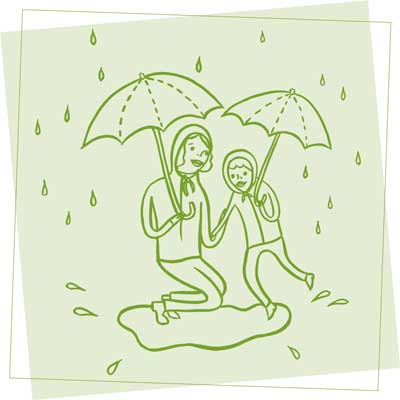
I Love Dirt!
52 Activities to Help You and Your Kids Discover the Wonders of Nature
Jennifer Ward
Foreword by Richard Louv
Illustrations by Susie Ghahremani

ROOST BOOKS
BOSTON & LONDON
2011
ROOST BOOKS
An imprint of Shambhala Publications, Inc.
Horticultural Hall
300 Massachusetts Avenue
Boston, Massachusetts 02115
roostbooks.com
2008 by Jennifer Ward
Illustrations 2008 by Susie Ghahremani
All rights reserved. No part of this book may be reproduced in any form or by any means, electronic or mechanical, including photocopying, recording, or by any information storage and retrieval system, without permission in writing from the publisher.
Library of Congress Cataloging-in-Publication Data
Ward, Jennifer, 1963
I love dirt!: 52 activities to help you and your kids discover the wonders of nature/Jennifer Ward; foreword by Richard Louv; illustration by Susie Ghahremani.1st ed.
p. cm.
Includes bibliographical references and index.
eISBN: 978-0-8348-2239-9
ISBN: 978-1-59030-535-5
1. Outdoor recreation for children. 2. Children and the environment. 3. Nature studyActivity programs. I. Title.
GV191.63.W36 2008
796.083dc22
2007029744
In my great-grandparents day, most people spent the better part of their lives outdoors. By necessity, they walked to school or work, tended the fields to grow food for the table, or fished a nearby lake. We wouldnt want to assume that generations physical hardships, but when it came to fun, that was outside, tooswimming, boating, hiking, skiingand the seasons were wired into their very being. They didnt have to think about nature as something to be attained, because it was integral in their lives, as it had been for untold generations. To be human was to be part of the natural world.
In the 1950s, when I was a child, I was outside playing in the nearby woods every chance I got. I fished, built tree houses, and walked with my dog, Banner, along every trail. And every year, my father drove the family on turtle patrol. My brother and I scooped up turtles crossing the country road to save them from passing cars. Some of those turtles came home with us for a season, and I learned firsthand about kindness and bootstrap conservationas well as something about turtles. Those family outings meant a great deal to me. I passed my stories along to my two boys when they were small and called them turtle tales.
Things are very different now. Our society has largely come to regard nature as separate from normal daily life, as little more than a passing dream on the other side of the SUVs windshield. That probably wont be national park scenery, either. Visits to U.S. national parks increased at a steady clip from the 1930s until 1987, peaking at an average of 1.2 visits a person per year. But over the next sixteen years, the number of people visiting those parks dropped by 25 percentpartly because of the growing disconnect between children and nature.
As a reflection of our national move indoors, we also see lower enrollment in college undergraduate conservation programs, a drop in sales for entry-level camping gear, and fewer kids jumping on bikes. Between 2000 and 2004, sales of childrens bikes fell by 21 percent, according to Bicycle Industry and Retailer News. There are even indications participation in organized sports is falling off. Meanwhile, it is no coincidence that child obesity rates are going off the charts, diabetes is a national concern, and attention deficit disorders and childhood depression continue to challenge parents and caregivers. Unfortunately, the rate of antidepressants prescribed to children has doubled in the last five years. For these and other reasons, some suggest children today may comprise the first generation since World War II to have shorter life spans than their parents.
As I wrote in my book Last Child in the Woods: Saving Our Children from Nature-Deficit Disorder, we are seeing children with tunneled senses and feelings of isolation and containment. What weve been ignoring as a society is nature, a potent therapy available at no cost. While nature experience should not be seen as a panacea, study after study indicates time outdoors in a natural setting is not simply a nice-to-have activity. It is a vital element for healthy childhood development. More than a hundred studies of adults and children show that spending time in nature reduces stress, while other studies show that contact with the natural world significantly reduces symptoms of attention deficit disorder in children as young as five.
A 2005 study by the California Department of Education found that students in schools with nature immersion programs performed 27 percent better in science testing than kids in traditional class settings. Similarly, children who attended outdoor classrooms showed substantially improved test scores, particularly in science. Such research consistently confirms what our great-grandparents instinctively knew to be true, and what we know in our bones and nerves to be right: free-play in natural settings is good for a childs mental and physical health. The American Academy of Pediatrics agrees, stating in 2007 that free and unstructured play is healthy and essential for children.
Fortunately, a number of state and local governments are beginning to catch on, and thanks to the efforts of citizen activists and conservation groups, such as the Sierra Club, what has been dubbed Leave No Child Inside legislation is finding its way to governors desks.
Next page
